TP-51D-25-NT Conversion
Air National Guard
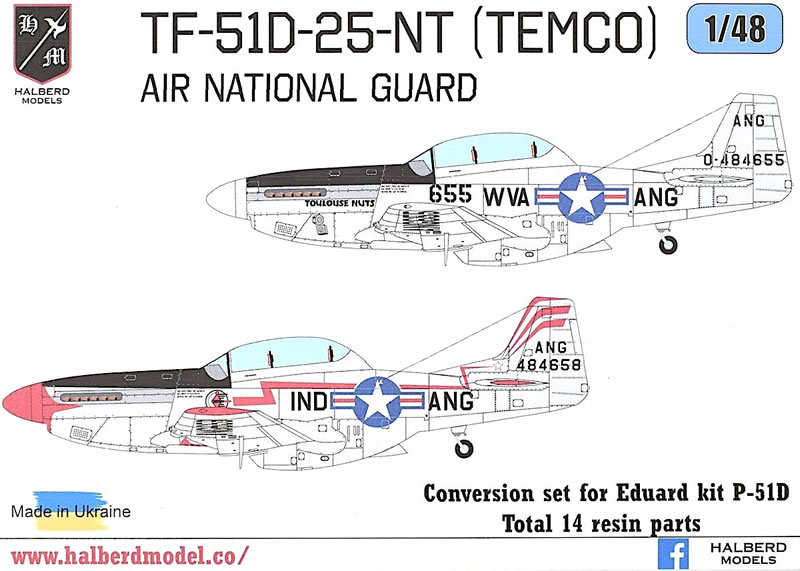
Halberd Models, 1/48 scale
S
u m m a r y : |
Description and Item No.: |
Halberd Models TP-51D (Kit No. not quoted) |
Contents and Media: |
14 parts in green resin, one clear part,, decals |
Price: |
USD $59.95 plus shipping from Halberd Models' website |
Scale: |
1/48 |
Review Type: |
First Look |
Advantages: |
To my knowledge the conversion by Black Magic Resin, is the only other option for building a 1/48th TF-51D. The resin fuselage by Halberd is highly detailed and beautifully cast. Pair this with parts from the Eduard P-51D and you’ve got a very nice model of a rare aircraft. |
Disadvantages: |
It might make you drop your current build and start it. |
Recommendation: |
Highly Recommended. |
Reviewed by John Miller

Halberd Models, a Ukrainian company, specializes in producing quality resin conversions and complete kits of rare or experimental aircraft. Their conversions often incorporate parts from mainstream, injected molded “donor kits” as with this TF-51D conversion, which relies on parts from the Eduard P-51D. The largest part of this conversion, the fuselage, is beautifully cast as are the parts for the dual-control, rear seat. I recently completed the Halberd XP-47H conversion and enjoyed the build immensely. For the hard-core Mustang fans out there, this is a conversion you’ll want to pick up.
Keep ‘em coming, Halberd!
Background
The North American P-51 Mustang is an American long-range, single-seat fighter and fighter-bomber used predominantly during WWII and the Korean War. Designed in April 1940 by a team headed by James Kindelberger of North American Aviation (NAA), the Mustang was produced in response to a request from the British, who had approached NAA to build the Curtiss P-40 under license for the Royal Air Force. NAA proposed the production of a more modern fighter and in short order the prototype NA-73X was rolled out on September, 9th 1940; just 102 days after the contract was signed. The prototype first flew on October, 26th. The Mustang was designed to use the Allison V-1710 engine without an export-sensitive turbosupercharger or multi-stage supercharger. This resulted in limited high-altitude performance.
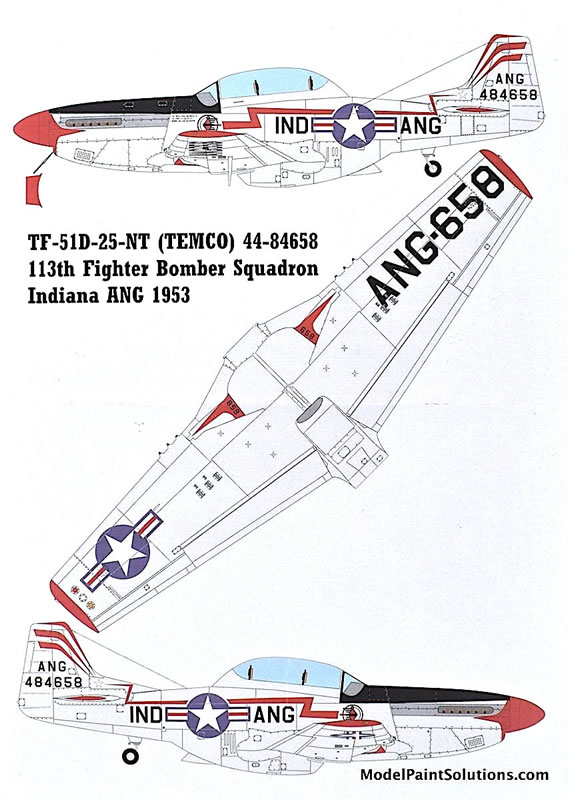
The RAF first flew the aircraft in combat as a tactical-reconnaissance aircraft and fighter-bomber (Mustang Mk I). In mid 1942, Rolls Royce replaced the Allison with a Rolls-Royce Merlin 65, two-stage, inter-cooled, supercharged engine, dramatically improving the aircraft's performance at altitudes above 15,000 ft (4,600 m) without sacrificing range. North American began converting several aircraft and developed the P-51B/C (Mustang Mk III), which became the first long range fighter able to compete with Luftwaffe fighters. The definitive version of the Mustang, the P-51D, was powered by the Packard V-1650; a license-built version of the two-speed, two-stage-supercharged Merlin 66. The aircraft was armed with six .50 caliber (12.7 mm) AN/M2 Browning machine guns.
From late 1943, P-51B’s and P-51C’s (supplemented by P-51D’s from mid-1944) were used by the USAAF’s Eighth Air Force to escort bombers in raids over Germany, while the RAF's Second Tactical Air Force and the USAAF's Ninth Air Force used the Merlin-powered Mustangs as fighter-bombers; roles in which the Mustang helped ensure Allied air superiority in 1944. The P-51 was also used by Allied air forces in the North African, Mediterranean, Italian, and Pacific theaters allowing WWII Mustang pilots to claim a cumulative total of 4,950 enemy aircraft destroyed.
At the start of the Korean War, the Mustang, by then re-designated F-51, was the main fighter of the United States until jet fighters such as the North American F-86 Sabre, were operational. During this period, dual-control TF-51D Mustangs were used for fighter pilot training until the T-33 was phased in. Despite the advent of jet fighters, the Mustang remained in service with some air forces until the early 1980s. After the Korean War, Mustangs became popular civilian war birds and air racing aircraft.
Text edited from Wikipedia.
In a sturdy cardboard box comes 13 parts in light green resin and one in clear. The fuselage halves are taped together and wrapped with bubble wrap while the smaller parts and rear canopy section are each provided in small zip-lock bags. To complete the kit you’ll need a donor kit in the form of the Eduard 1/48th P-51D. Kits recommend in the Halberd instructions include Eduard 1/48th P-51D overtree numbers 82101X and 82102X as well as F-6D/K overtree 82103X.
There is a bit of flash that will require some clean-up. That said, the fidelity of the detail on the fuselage halves is stunning. The details, both inscribed and in-relief, are crisply rendered and scale-appropriate. As with their P-47H conversion, the folks at Halberd Models make some of the finest resin parts this reviewer has seen.
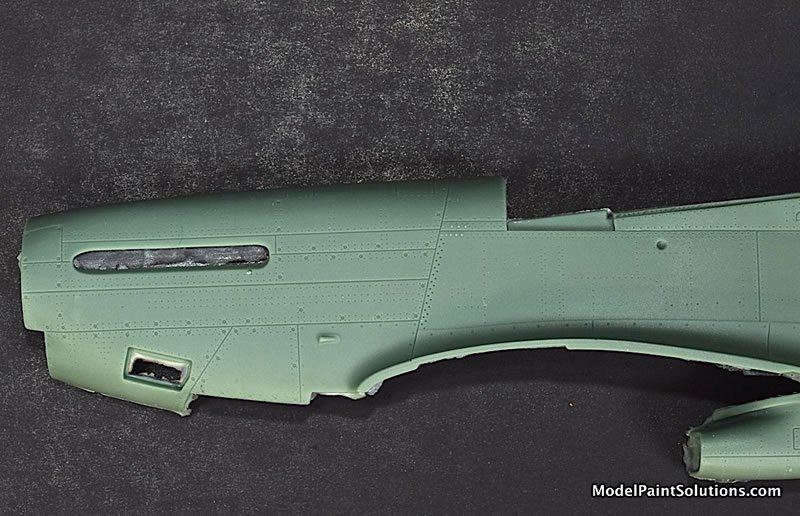
As with the exterior surface details, the cockpit side panels are beautifully-cast and will look great under paint and a wash.
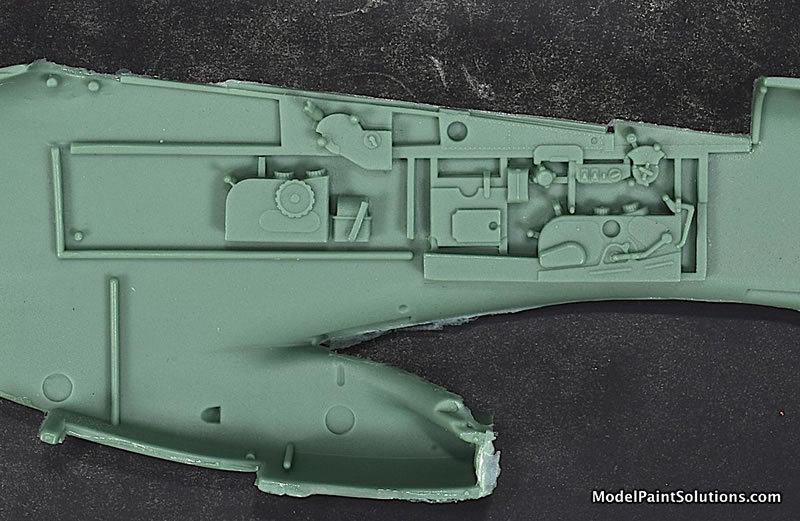
Assembly starts with the cockpit. The kit provides both front and rear seats, the rear instrument panel and control stick, as well as rear rudder pedals and an elongated floor board. Parts from the Eduard P-51D are utilized for the front cockpit.
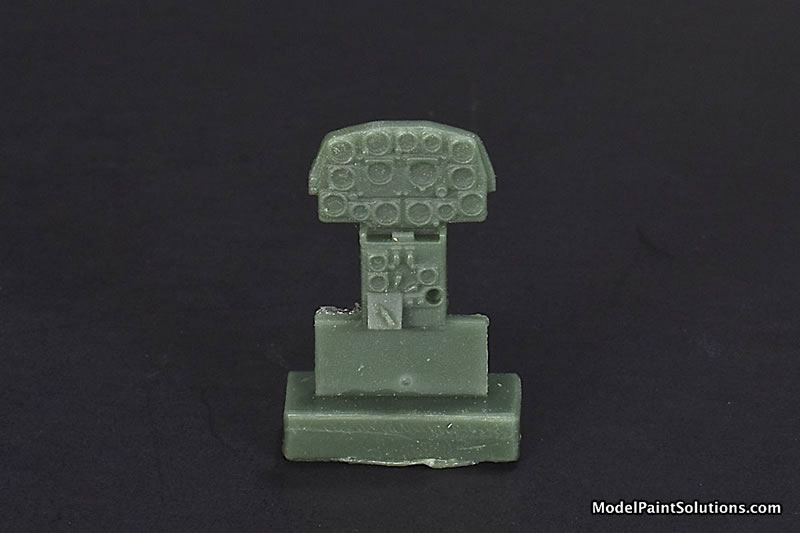
The rest of the parts including the wings, horizontal stabilizers, elevators, landing gear, gear doors, and propellor/hub are sourced from the Eduard P-51D. As per the instructions, a small bracket has to be removed from the Eduard tail wheel assembly and a hole has to be drilled under the port wing to accommodate a small blade antenna (provided in the kit). Man, this is going to be a beautiful kit when assembled.

The single-piece, rear canopy section comes on a pouring lug, which will have to be removed prior to use. The clear resin is beautifully cast but will require a little buffing to achieve sufficient clarity; nothing a few minutes with 8,000 and 12,000 grit Micromesh won’t fix.
Color and Markings
The decals, by Decograph are crisply printed with good registration and color density. Markings are provided for 2 airframes, both from Air National Guard units of the mid 1950s.
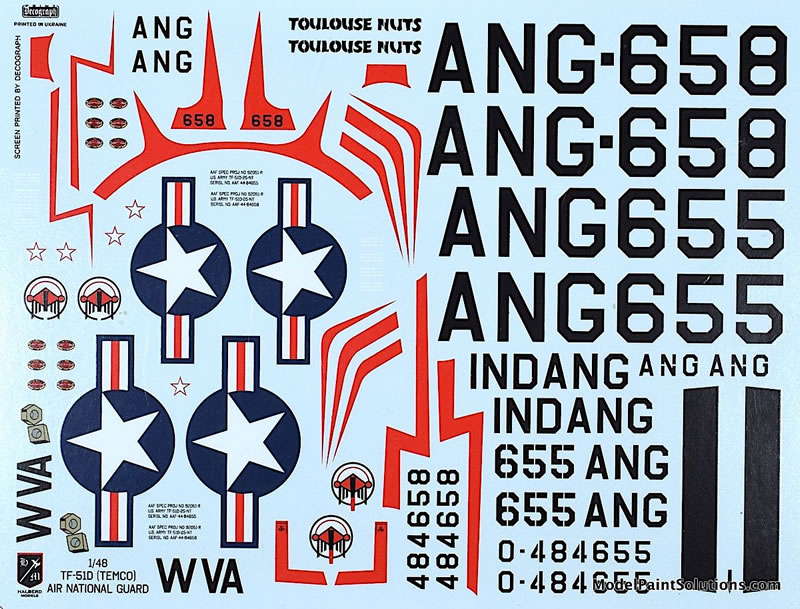
They are:
-
TF-51D-25-NT (Temco) 44-84658, 113th Fighter Bomber Squadron, Indiana ANG, 1953.
-
TF-51D-25-NT (Temco) 44-84655, 167th Fighter Bomber Squadron, West Virginia ANG, 1955.
Wowza! This is some very fine resin, indeed. Combine that with the quality styrene parts from the Eduard kit and you’ve got a stunning model when assembled. If this TF-51D goes together as easily as does their P-47H conversion, Halberd has another winner on their hands and we have yet another model of a rare but historically significant aircraft underserved by larger model manufactures.
Thanks, Halberd!
Keep your airbrush wet!
—John
For more on this review visit ModelPaintSolutions.com.
Text and images copyright ©2024 by John Miller/Model Paint Solutions.
Review Text and Images Copyright © 2024 by John Miller / Model Paint Solutions
Page Created 21 June, 2024
Last updated
21 June, 2024
Back to HyperScale Main Page
Back to Reviews Page

|
Home
| What's New |
Features |
Gallery |
Reviews |
Reference |
Forum |
Search